Less Choice Than You Might Think (David)
We counted ourselves lucky to find a suitable weather window within a week of being ready to leave
Wellington. We've been on this voyage for three weeks and most of our movements have been
determined for us by the weather.
The Wairarapa Coast passage was dominated by two things. Foremost was to put this fickle and
dangerous part of the coast behind us. The other was 'getting our sea legs'. We were all a little clumsy
and unsteady on our feet. Janet, true to form, was unsteady also in her gut. Navire, and we, lurched and
slewed in the steep seas and cross swells.
I breathed more freely early on our second day as we slipped past Cape Turnagain. The air was warmer.
We could expect correspondingly moderate winds and flatter seas. So when rain and blustery squalls
forced us back into our wet weather gear, I was a little miffed.
Mahia Peninsula appeared around three the following morning. The reassuring light at Table Cape kept
disappearing in walls of rain and hail. Hail and a stiff, cold southerly was not what we had in mind for
Gisborne. We were running on a double reefed main and tiny storm jib, overtaken regularly by black
squalls and pelting rain. A bleak, grey dawn gave us our first view of Poverty Bay and the approaches to
Gisborne. We stowed the mainsail to slow us down so as not to arrive in the marina before the manager.
We thought we might need his help. The wind appeared to be blowing directly down the channel to the
boat harbor and I worried that we would be berthing Navire in a cauldron of churning water and wind
gusts. I needn't have fretted. The heaving seas stopped abruptly at the breakwater.
The following day Gisborne showed us her usual sunny face.
The timing of our next passage, around East Cape, was determined by a forecast of westerly winds in the
Bay of Plenty. We had to get to Tauranga before these set in or we'd have wind on the nose for a
hundred miles. There was no lingering in Gisborne.
Past the Cape we revelled in flat seas and sunny skies, sailing in very close to White Island, all steam and
sulphur and strangely beautiful, tortured, pink moonscape. By day's end we were hove-to off Tauranga
for the night.
Soon after our arrival at the marina we appreciated the wisdom of their instructions to come into the
port at slack tide and during marina office hours. On both ebb and flood tides there is several knots of
current through the marina which has caused great difficulty to vessels berthing. The manager regaled
us with stories of powerful boats turned side-on in the fairways, jammed up against the wooden piles
and unable to get off or of being driven on the rocks at the ends of the breakwater. Arriving and
departing vessels are routinely assisted by someone in an inflatable dinghy with a big outboard. I've
never before used a marina that issues users with an instruction leaflet for maneuvering in their facility.
Apart from waiting for the turn of the tide, there was no particular imperative determining our
departure. We just wanted to get on with cruising and avoiding city costs.
We could happily have stayed on at our next stop, Tuhua (Mayor Island), were it not for the forecast of a
strong south-easterly, the one wind direction in which the enchanting anchorage is unsafe. If ever you
get a chance to visit this island, take it. It's a volcanic cone with two swimmable lakes within the rim and
thick with Pohutukawa, some ancient. The island is recently pest free and criss-crossed with Hansel and
Gretel paths in the woods. Vicki, the island's manager, was very welcoming. When I remarked to her
partner on the exceptional beauty of the island and asked how one might marry into the family, he
laughed and said, 'That's how I got here.'
A long spell of strong easterly winds, generated by two low pressure systems coming across the Tasman
followed by a tropical depression, was already generating wind warnings for our region. Our debate
between the safety of Whitianga Marina and the west side of Slipper Island was resolved by a launch
owner who extolled the comfort of Slipper. A mooring, recently checked, was available, he said. It came as a bit
of a surprise that, in an easterly, Slipper Island is about the only suitable anchorage on this, the eastern
Coromandel Coast. We are told that once the winds are up, getting into the marinas at Whangamata,
Tairua and Whitianga is inadvisable.
At Slipper the mooring was there but it didn't have that 'recently checked' look about it and Justin, a
young farm worker from the island could not say when last it had been looked at. Justin gave us his
phone number, just in case.
"We're pulling our work-boats out of the water," he said. "We don't know what were in for tonight."
"I hope this mooring holds." I said, looking at the shell encrusted rope.
"Me too," said Justin. "If it gets too rough and uncomfortable, you're welcome to come ashore, although
I suppose you'll want to stay with your ship."
We hung on that dubious mooring for two nights, yawing wildly in the gusts and lurching in the steep
cross swell. We set our GPS alarm and got up frequently. It was not a relaxing stay and we never got
ashore. But we did fill our tanks with lots of silky rain water.
When the winds were forecast to increase and back to the north east we knew we had to move. There
was really only one option other than running back to Tauranga - Mercury Cove on Great Mercury
Island, thirty miles north and a run of five or six hours for us. The cove is much vaunted as an all-weather
bolt hole and early on the second morning we bolted for it.
Dawn was grey, windy and wet. As soon as we poked our nose past the north end of the island we got
the full effect of the swell that had had the entire, unimpeded expanse of the Bay of Plenty to reach its
full height of about four metres. We had not experienced seas of this size before. As each successive
wall of foaming water muscled down on us, Navire miraculously lifted herself effortlessly up, up, up and
over. Occasionally a swell would contrive to meet Navire just as it was drawing breath, its stomach
pulled in, its massive head, all white foam and fury, leaning out over its body. Then oceans of water
would fall on the cabin top and fill the cockpit. I gradually got better at anticipating these and ducking
under the dodger.
The wind varied between twenty and forty knots, on the beam, and we charged along at six to seven
knots. With the wind vane temporarily out of action and conditions too severe for the electronic auto
helm we were reduced to hand steering. All was grey, the sky, the mountainous seas and the land.
There was too much of the land for my liking. Piling up on a rock this early in the voyage was an indignity
I was keen to avoid. It took all our combined concentration to sort one rock or islet from another. Still,
I can remember doing this before GPS. Then we were without the magic of seeing our position,
constantly updated, on an electronic chart. 'Heart in mouth' applied then in a way it rarely does now.
Sailing from the ocean's roar into the lee of high land is one of the sweetest treats in this business. The
transition is instant and glorious. The wind drops. The water flattens out. Not infrequently the sun
comes out. We eased along under the golden hills of Great Mercury Island and dropped anchor a stone's
throw from Michael Fay's bach, available to rent for just $2000 a night.
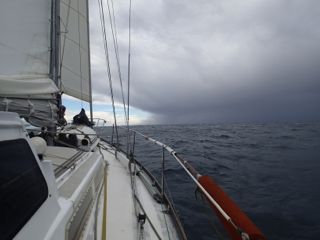

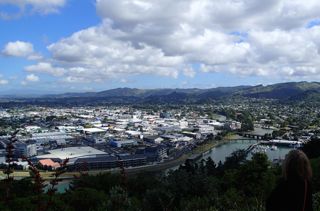
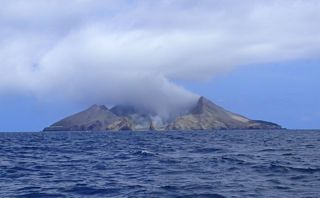
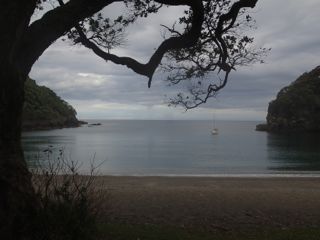
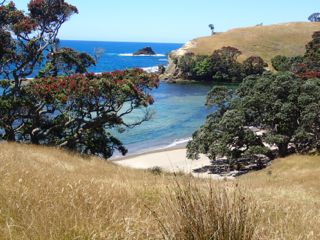
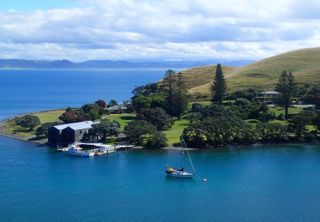
Add new comment